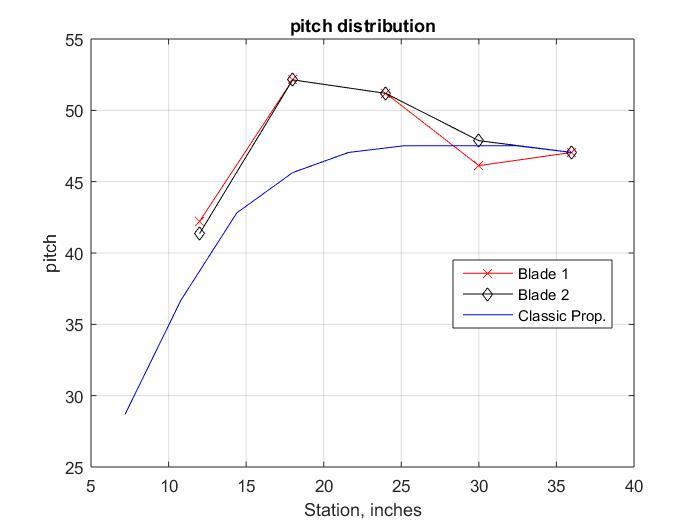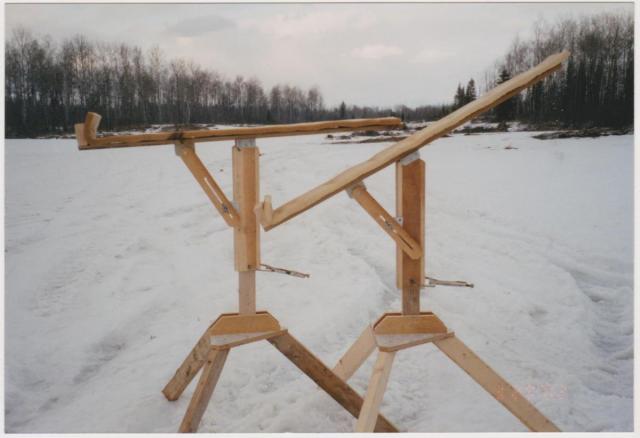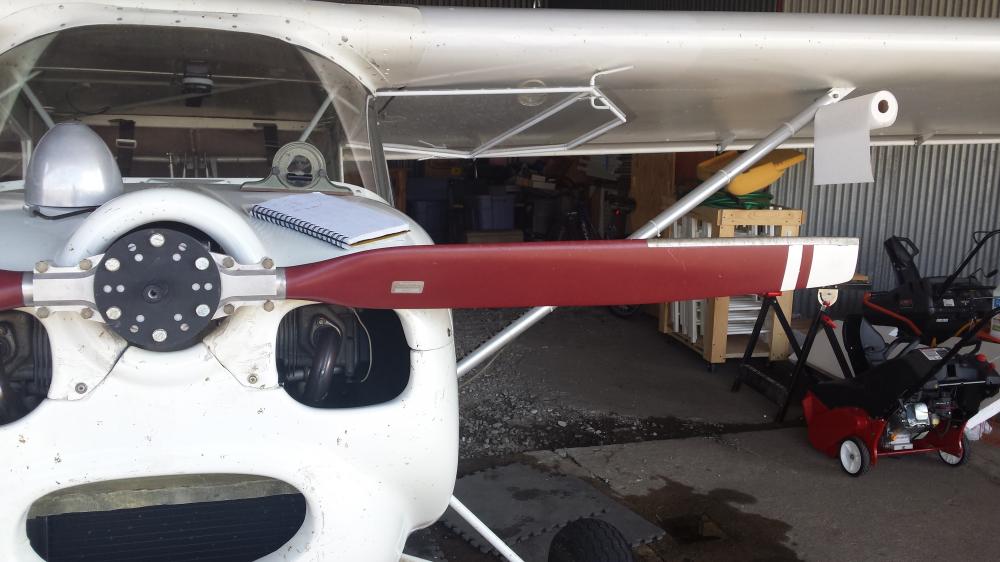-
Content count
104 -
Joined
-
Last visited
Posts posted by Geoffrey Thorpe
-
-
Found out it had massive toe-in
If that won't make it scary, nothing will. I would start by fixing this.
Forward CG is not an issue for ground handling. I doubt that you would need mondo springs if you got the tow in fixed. Got a big pipe wrench?
-
If you are not fussy about the surface finish on the mold side, duct tape and packing tape work well as a "mold release". If the surface has too much curve, rip the duct tape into strips.
-
They have 2 types of fittings - I believe that these are what are on my ride. http://www.aircraftspruce.com/catalog/hapages/nutsleeveassembly.php
-
After having been thru the AW process on a plane that had previously flown and been registered..never ever ever again.
Would you mind writing up a rough outline of how you were able to accomplish this?
-
Specs be here: http://www.d-motor.eu/nl/products-2.htm
Surprised to see someone building a flat head engine. But it is more compact even if the heat losses are higher, I guess we don't care about emissions, and it is a slow rev design...
Flipping through the manual, they recommend auto fuel - period - and a fully synthetic oil. Not so great for applications here in yea olde USA where there is leaded fuel at most airports.
-
OK, a day late and a dollar short - I went looking for the weight spec for the floats and found a service bulletin that I had not seen before on checking the float level... http://legacy.rotaxowner.com/si_tb_info/serviceb/sb-912-065ul.pdf
But, back on topic - any landing you walk away from...
-
-
Was the engine pickled?
Kinda late, but better than never - drain all fuel from fuel lines, gascolator, carbs. Spray some fogging oil into the cylinders at a minimum. If there was an oil change done when it was put away, fine. If not, consider at least changing it even if the engine is cold.
-
Here is what you need to put the wings on fairly easy. I've put wings on a bunch of planes by myself using them. The scary part is lifting them up on to the stands by your self and worrying about dropping one and messing it up. Jim Chuk
I used a panel lift (drywall lift) to hang my wings.
10 minutes of your life you will never get back: https://youtu.be/inHNNG1EDig
1 person likes this -
Some "free form" hydroforming fwiw...
2 people like this -
I (currently) use the cabin for the static source. Opening and closing the round pop out vents that I have on the doors makes about a 5 mph change in indicated air speed (IIRC).
I like the idea of cutting an inspection port in the bottom for access as outlined in the directions that were attached.
-
Was that WD prop repainted? Don't think I have ever seen a red one with white tips. EDMO
That's the way it was when I bought the airplane. I have no Idea if it may have been painted at some time.
-
I have an old ground adjustable Warp Drive prop that I have never been real excited about - if nothing else, it has a really big clunky hub that has to be wasting a lot of energy just beating up the air...
So, I've been thinking that carving my own might be a fun project. And, the logical first step (at least in my mind) would be figuring out what pitch my current prop is set at. So, measuring tape and bubble protractor in hand, I spent some time at the hangar and came up with the plot of pitch as a function of radius at several points, and this is what I get:

[The "classic prop" line is from a spread sheet that I found online (http://www.nmine.com/propeller.htm)]
The decrease in pitch from my measurements as it gets towards the tip seems odd to me (assuming my calculations are correct). I would guess that it might be that the blade twist was optimized for some pitch other than where I have mine set - I will play with the numbers a bit. But I would think that the pitch distribution can't be helping my performance.
For those that actually know something - does the pitch distribution for the "classic prop" seem reasonable? Does it look like I did something wrong? Comments?
My raw numbers / calculations:
% find the average pitch of a propeller from angles and radial location
% assumes angle of back of blade is the chord angle% enter data here:
% Angle of hub. degrees (negative means that top of surface is aft of
% bottom)
ah = -8.75;
% Location of angle measurements (inches from center)
dim = [12 18 24 30 36];% angle of blade at each measurement (degrees) blade 1 and 2 - all
% measurments with blade to port side of the aircraft (leading edge up and level)
ab1m = [20.5 16 10 5 3];
ab2m = [20 16 10 5.5 3];% end data entry
% correct angles for angle of hub
ab1a = ab1m - ah;
ab2a = ab2m - ah;% circumfance at each measurement
cir = 2*pi*dim;% calculate pitch for each point.
p1 = cir.*tand(ab1a);
p2 = cir.*tand(ab2a); -
2 people like this -
For those who don't get kitplanes
http://raa.ca/magazine_pdf/tech articles/Leading Edge Vacuum Forming.pdf
And, a video: https://youtu.be/2_QWPoFEhWc
1 person likes this -
Pitch is reasonably straight forward to calculate given an actual propeller - set the prop face on a level surface and measure the angle of the back of the blade from horizontal with a bubble protractor at one or more known radii, then: Pitch = tangent(angle)* 2 * pi* radius.
You will find that the pitch likely varies somewhat with radius.If the propeller is on an airplane, measure the difference in angle between the hub face and the back of the blade...
-
Wish I could help in this area. I've designed and built my own props for exactly the reasons you guys bring up. Not to mention the cost. The last few I built would out perform anything that I had that was "store" bought. With the insurance requirements I can't afford to make them for others though.
One thing that I've found on my 60 HP VW, 1" of prop diameter is equal to about 150 RPM. So if I decrease my diameter 1/2" on EACH blade (1" diameter) I will gain 150 RPM. The same applies if I increase the length. We all know that you can limit your max RPM by the size and pitch of the prop but there are design differences between every manufacturer that will either gain or lose performance. Just some thoughts that probably don't play into the conversation as much as I'd like to be able to relay. They do make sense in my head though.
Hijacking the thread... Do you use a constant pitch (of course the angle changes) from root to tip or do you modify it as a function of diameter?
-
Just for the record...
The chances of me ever owning a Catalina are somewhere between slim and none, but none the less, I have really been enjoying reading this thread (and other similar threads) with the pictures of the progress and some discussion about the thought processes to get there. Thanks to all of you for taking the time to post this stuff.
-
Well, there is the don't ask don't tell option.
The last issue of Kitplanes addressed the placard idea - the DAR guy says a placard doesn't cut it. But that's an opinion.
-
Of course, it can never qualify as an LSA again which may hurt your resale...
-
It seemed to be mostly stained - not lifting from the fabric. But I chose to replace the fabric rather than mess around.
-
I have heard that Poly-Tone doesn't take gas spills well, Is that true? I am not against Poly-tone by any means and the price is very appealing compared to aerothane, For those of you that have used Poly-tone, are you happy with how it all turned out and would you do it again,
Depends on how much and how often you spill. A leaking full level sender will make a real mess over time. But, I would use it again because it's easy to repair - so far I have had fuel tanks out three times :-(
-
TJay, Hope you have a fresh air breather if you spray this Urethane - If you go out, you wont come back on! EDMO
Cant be a whole lot worse than that poly-brush was to spray. Or any of that stuff I did in my early 20s
It can be a whole lot worse, and it is a whole lot worse.
In addition to being really really bad, it has, and I quote, "Poor warning qualities" which means you don't realize that you are getting nailed. With the polytone, or other old style paints you knew when your respirator was used up by the smell. Not so with the two part urethane. That's why you really, really want a source of outside air.
Paint suit, good gloves, and outside air.
-
That middle pic looks like the cylinder walls are corroded or pitted??? Or is it just the pic?
Corrosion or a reflection of the deposits on the top of the piston?
1 person likes this



Caculating Edge Distance
in Technical tasks
Posted
An AN-6 bolt in double shear should be good for about 16000 pounds. An AN-5 is about 11000. (per attached)
My calculations for my 1300 pound Merlin GT (single strut) comes up to 5100 pound of tensile load in the strut at 3.8 G - but those are my numbers, ymmv, use at your own risk, no warranty expressed or implied, do not attempt at home, etc.
Just off the top of my head, I would guess that the loads on the two struts on something like an Avid would be on the order of 75% front, 25% rear (+- 100% or so).
AN3THRUAN20-REV12.006281.pdf